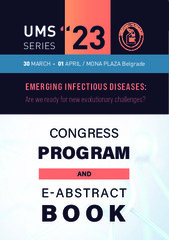Приказ основних података о документу
Antitela specifična za SARS-CoV-2 nakon iRNK vakcine kao treće doze: homologi i heterologi pristup revakcinaciji
SARS-CoV-2 specific antibody response after an mRNA vaccine as the third dose: homologous versus heterologous boost
| dc.creator | Lijeskić, Olivera | |
| dc.creator | Srbljanović, Jelena | |
| dc.creator | Bauman, Neda | |
| dc.creator | Bobić, Branko | |
| dc.creator | Štajner, Tijana | |
| dc.date.accessioned | 2024-01-31T04:47:32Z | |
| dc.date.available | 2024-01-31T04:47:32Z | |
| dc.date.issued | 2023 | |
| dc.identifier.isbn | 978-86-914897-9-3 | |
| dc.identifier.uri | http://rimi.imi.bg.ac.rs/handle/123456789/1452 | |
| dc.description.abstract | Implementacija treće doze vakcine protiv SARS-CoV-2 u preporuke širom sveta otvorila je polje istraživanja heterologog pristupa revakcinaciji, odnosno kombinacije primarne serije vakcine i treće doze različite vakcinalne platforme. Iako je literatura bogata radovima na temu heterologog pristupa, imunogenost i trajanje humoralnog imunskog odgovora nakon kombinacije inaktivisane BBIBPCorV i iRNK vakcine nisu dovoljno istraženi. Stoga, cilj ove studije bio je ispitivanje razlike u imunogenosti i dugotrajnosti humoralnog imunskog odgovora u okviru perioda od šest meseci nakon treće doze kod homologog (tri doze BNT162b2) i heterologog (BBIBP-CorV/BNT162b2) pristupa revakcinaciji tokom Omikron talasa u Srbiji. U studiju je uključen 91 ispitanik, od kojih se 55 odlučilo za homologi a 36 za heterologi pristup. Serumi ispitanika analizirani su u četiri vremenske tačke: šest meseci nakon prve doze, a zatim tri nedelje, tri meseca i šest meseci nakon treće doze. IgG antitela specifična za receptor-vezujući domen “šiljastog” (eng. spike) proteina detektovana su BioMerieux VIDAS SARS-CoV-2 IgG testom. Tri nedelje nakon treće doze, oba pristupa revakcinaciji dovela su do značajnog porasta u koncentraciji antitela (p<0.0001). Štaviše, ispitanici koji su se opredelili za heterologu kombinaciju imali su statistički značajno više koncentracije antitela od homologe grupe, u kontrolnim vremenskim tačkama na tri nedelje i tri meseca nakon treće doze (p=0.025, p=0.0006). Međutim, značajan pad humoralnog imunskog odgovora zapažen je tokom vremena kod oba pristupa. Većina infekcija nakon vakcinacije registrovana je u periodu između tri i šest meseci nakon treće doze (n=22), a ukupna incidencija ovih infekcija za posmatrani period iznosila je 36.36% (20/55) nakon homologog i 16.67% (6/36) nakon heterologog pristupa. Međutim, ispitanici sa potvrđenom infekcijom nakon vakcinacije nisu imali pneumoniju niti su bili hospitalizovani. Iako je heterologi pristup indukovao više koncentracije antitela, naši rezultati ukazuju da su i heterologi i homologi pristup indukovali potentan humoralni imunski odgovor i odgovarajuću zaštitu od hospitalizacije i smrtnog ishoda tokom Omikron talasa. Međutim, opadanje imunskog odgovora opaženo kod oba vakcinalna pristupa u periodu od šest meseci, kao i konstantna opasnost od pojave novih pretećih varijanti, ukazuje na potrebu preispitivanja trenutne vakcinalne strategije. | sr |
| dc.description.abstract | Worldwide implementation of the third dose of vaccine against SARS-CoV-2 opened a new field of research concerning the heterologous boost i.e., the combination of the primary vaccine series and a different vaccinal platform for the third dose. Although literature is replete with studies of heterologous boosts, longevity and immunogenicity of the inactivated BBIBP-CorV and mRNA BNT162b2 combination remains under-explored. Thus, the aim of this study was to evaluate the differences in immunogenicity and longevity of the humoral immune response within six months after the third dose in both homologous (BNT162b2) and heterologous (BBIBP-CorV/BNT162b2) vaccination setting, and to assess the real-life data in the middle of the Omicron surge in Serbia. A total of 91 individuals were included in this study, of which 55 received homologous and 36 heterologous boost. Serum samples were analyzed at four timepoints: six months after the first dose; three weeks, three months, and six months after the third dose. Specific IgG antibodies against the receptor-binding domain of the spike protein were detected using BioMerieux VIDAS SARS-CoV-2 IgG kit. Both groups showed a highly significant increase in antibody concentrations (p<0.0001) three weeks after the boost. Furthermore, comparison per timepoint has shown that recipients of heterologous boost had significantly higher antibody concentrations than homologous group, at three weeks and three months after the boost (p=0.025, p=0.0006). However, a significant decline in antibody response over time was noted for both strategies. The majority of breakthrough infections were registered in the period between three and six months after the boost (n=22).Furthermore, total incidence was estimated at 36.36% (20/55) for homologous group, and 16.67% (6/36) for heterologous group. Most importantly, none of the recipients of the third dose developed pneumonia during the breakthrough infection, and none were hospitalized. In conclusion, although heterologous approach resulted in higher antibody concentrations, our findings imply that both homologous and heterologous boost induce potent humoral immune response and adequate protection against hospitalization and death in the Omicron setting. However, waning immune response registered for both types of boosts within six months and constant threats of new emerging variants, calls for an update of vaccine strategy. | sr |
| dc.language.iso | sr | sr |
| dc.language.iso | en | sr |
| dc.publisher | Belgrade: Serbian Society for Microbiology | sr |
| dc.relation | info:eu-repo/grantAgreement/MESTD/inst-2020/200015/RS// | sr |
| dc.rights | openAccess | sr |
| dc.source | 23 UMS Series "Emerging infectious diseases: Are we ready for new evolutionary challenges?”, 30 March - 01 April, 2023, Belgrade, Serbia – E Abstract Book | sr |
| dc.title | Antitela specifična za SARS-CoV-2 nakon iRNK vakcine kao treće doze: homologi i heterologi pristup revakcinaciji | sr |
| dc.title | SARS-CoV-2 specific antibody response after an mRNA vaccine as the third dose: homologous versus heterologous boost | sr |
| dc.type | conferenceObject | sr |
| dc.rights.license | ARR | sr |
| dc.citation.epage | 82 | |
| dc.citation.spage | 79 | |
| dc.identifier.fulltext | http://rimi.imi.bg.ac.rs/bitstream/id/3400/bitstream_3400.pdf | |
| dc.identifier.rcub | https://hdl.handle.net/21.15107/rcub_rimi_1452 | |
| dc.type.version | publishedVersion | sr |

